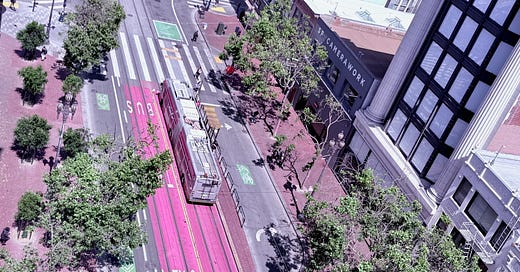San Francisco Mayor Daniel Lurie announced last month that Waymo’s autonomous vehicles would be allowed to operate on Market Street, the city’s main transit artery, which carries 200 buses and 800 bikes per hour during peak times.
Transportation safety advocates immediately protested. AV proponents were perplexed. Why would they oppose expanded access for the safest vehicle on our streets? Understanding this disconnect—and mapping a path forward—illuminates both the threat and the potential of autonomous vehicles.
As a bike rider, I love Waymo’s AVs. Their behavior around me is impeccable. When I take the lane for safety, they wait patiently behind me—something human drivers rarely do. They never speed. I wish all vehicles operated with such care.
But they’re still cars, and having too many of them is a problem. (Don’t we know it?!) On Market Street, in particular, even “just a few” could be “too many.”
Market Street has two lanes in each direction with no bike lanes and no realistic way to add them. Railcars, most buses, and the occasional taxi use the center lanes; bikes share the curb lane with some buses and the occasional delivery vehicle. It works because there’s almost no car traffic. Adding even a handful of cars to this delicate mix could devastate both safety and efficiency.
In the center lane, passengers use boarding islands designed to accommodate two transit vehicles. If even just two cars are queued next to the island, there’s no room for the second bus, which would have to wait an entire signal cycle to serve the stop. Delays would compound, translating to millions of dollars in increased operating costs, degraded service, and lower ridership.
The curb lane can’t easily accommodate more cars either. Congestion there would effectively erase what functions as a bike lane, forcing cyclists and scooter riders to risk filtering between cars or swerving into the bus lane. What’s currently a pleasant, low-traffic ride would become an unpleasant or dangerous one.
Too many cars on San Francisco’s Market Street, prompted by Waymo’s request for access, is a microcosm of the threat posed by autonomous vehicles. What is the potential?
Waymo, uniquely, could operate on Market Street without causing these problems. Its centralized computer knows where every vehicle is at all times, allowing it to limit the number of cars on any given block. It could optimize its usage, taking advantage of Market Street during off-peak hours when buses are sparse, and avoiding it during peak hours when buses and bikes dominate. Its vehicles can be trusted to respect the safety of cyclists and scooters in the curb lane.
This centralized control of AV routes could be transformative. We could direct AVs away from bike boulevards. Neighborhood residents could reclaim their streets for children’s games or street parties, with AVs automatically rerouting without complaint. People often resist being told they can’t drive on a street because kids want to play. But they’ll gladly jump in an AV and follow whatever route it takes—just as they already do with Google’s directions, often without even knowing where they are.
To the extent that AVs make car travel easier, they pose a threat. But to the extent that we can regulate where and how they travel, they could revolutionize our ability to create walk- and bike-friendly spaces where people and businesses thrive. The real question is: will we have that regulation?
In California, cities currently lack the authority to regulate AVs—or even Uber and Lyft, for that matter. Thanks to heavy lobbying by Uber and Lyft and the cooperation of Governor Newsom, that authority belongs solely to the California Public Utilities Commission. Local jurisdictions must be empowered to regulate autonomous vehicles independently from other vehicles.
Autonomous vehicles are coming. More companies will follow Waymo. Teslas will likely be approved for autonomous operation (despite their lack of LIDAR, because Mr. Trump will say so).
It’s imperative we get the right regulations in place now. AVs must be required to adhere strictly to speed limits, safe passing laws, and other safety rules. Their routes must be controlled to avoid streets prioritized for non-automobile uses. If — and only if — we can regulate them this way, the arrival of AVs could be a very good thing.





Interesting discussion, Dave. SF has had the most experience with robocars in the world. We will need good analysis and data from there. I feel safer riding around a Waymo than a human driver, but I wish neither were clogging our streets.
Unfortunately, Waymo is "just the tip" and there's no way for our new mayor to let one in and not open the floodgates for all their competitors, both other AV companies like Xoox, and ridehails like Uber and Lyft.
And, wouldn't you know it, Uber has already threatened to send their black cars onto Market as soon as Waymo is allowed. Maybe they can get away with it, but maybe that's the kind of tone deaf announcement that gets people riled up.
So yeah, just a few is never just a few. If Waymo gets to drive on Market, then everybody is going to be driving on Market.